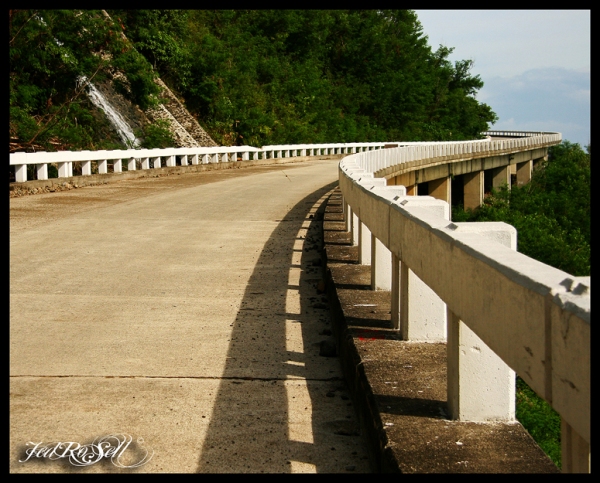Ilocos Norte Travel Guide
Pagudpud = “Pagod na, upod pa (ang gulong sa layo ng biyahe)”. [Translates to: "Pagudpud = 'Tired, and worn out (the tires due to the long trip)', though it doesn't sound so funny when translated to other languages. Is it going to be funny in Mandarin, German, etc?]
Probably the most common joke one hears every time the coastal town up North is the subject. I’ll leave the job of creating a new joke about Pagudpud to joke-makers like my good friend, Uli Oposa, but for now I’d like to share my experience and thoughts to one of my favorite provinces in the country, Ilocos Norte. Lately I’ve been fond of searching the net for etymologies, and name histories of places, so before I begin, I’d like to tell where the name “Ilocos” came from for all those who share the same curiosity like me. After a few researches, the province’s history came to light: Ilocos is actually “Ylocos” which came from the word looc, meaning sheltered cove. Juan de Salcedo, a significant guy in Spanish Colonialism in the Philippines, saw numerous loocs, where people live in harmony, thus, calling the place Ylocos, and Ylocanos, its inhabitants. Wow! Some information, huh? Anyway, it was really a long trip up there, so I might as well begin story telling (As much as I want to shorten my Ilocos story, I always end up telling our stormy journey as we head North, you can skip this boring part if you like).
Rain started to pour as I head to Tiendesitas to meet my Laguna travel buddy and house mate, Joey Goh. No signs of sunny weather in Manila earlier that afternoon so I hoped the rain clouds might spare us and head a different path as we begin the trip. Unfortunately, the “ssssshhhhhh” sound of the rain as it splashed through the windshield became a thud as rain droplets become rain drops indicating a heavy down pour through the night. But Joey and I have no second thoughts on continuing our journey, so we just keep our hopes up, hoping for the best, but expecting the worst.
After picking up 2 of our companions in Cainta, we began our journey at exactly 10:00 PM while the rain subsided for a while. Weather condition on NLEX and SCTEX was fine until we exited in Tarlac, where the rain started to pour again. Water filled the holes in the streets of Urdaneta City during that time, so we are forced to slow down. The down pour became even worse when we reached Rosario, and visibility reduced to 30%. Wipers and bright lamps were no use. We have no choice but to halt.
Thirty minutes have passed, and the rain became drizzle, we took advantage of the moment and speed up to catch up with the rest time aquired. San Juan, La Union was the farthest Northern town I’ve reached, and I had no idea that the province was really that long, then I started to get exhausted. Seeing the Ilocos Sur arch got me excited and my adrenalin started pumping.
 Enduring rains from South to North
Enduring rains from South to North
 Pulling over to glance at the open sea somewhere in Narvacan
Pulling over to glance at the open sea somewhere in Narvacan
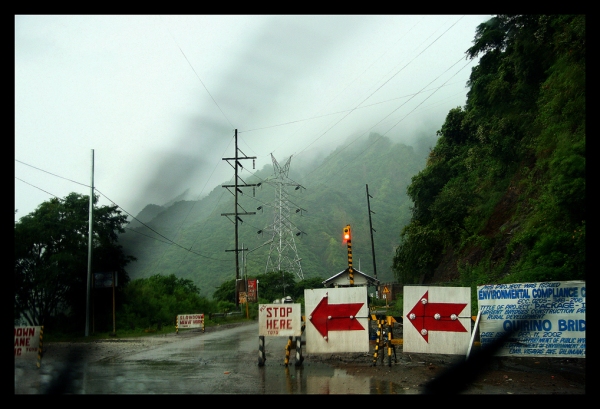 Aside from the heavy down pour, the Quirino bridge, under construction during that time, contributed to our slow journey.
Aside from the heavy down pour, the Quirino bridge, under construction during that time, contributed to our slow journey.
Skies were purple when we reached Candon City, Ilocos Sur where we stopped for gas, some quick bites, and smoke. The drizzle came to a halt, and signs of a semi-sunny day our hopes our starting to come true. As light brightens the road, it also revealed the South China Sea to our left. Though Vigan, our breakfast stop is near, we still decided to stop by Narvacan and indulge ourselves in the calm morning seas, cold sea breeze, and serenity of the place.
Rain drizzled once again while we were having breakfast in Vigan, and continued our journey after tummies were filled, and energy was back. It was still drizzling when we we left until we reached Laoag. The sun peeped through the thick clouds, and as we got near Pagudpud, more excitement ran through our veins. However, clouds began forming again as we exited Ilocos capital city, Laoag, also known as, “The Sunshine City”.
Finally, after 14 hours of driving, we reached the town of Pagpudpud, Ilocos Norte.
I’ve never drove that far my entire life. Though tiring, there was a feeling of fulfillment. I was exhausted, but I did not drove all the way to Northernmost province of Luzon to rest right away. No, my friend. Even though rain was drizzling, I ran to the beach, knelt, sat, and thanked the Lord for the safe trip amidst the storm, and giving me a chance to be in this place. In addition, I took some time to breathe the breeze in, and appreciate the place.
Since it is the rainy season, there were not a lot of tourist go to the beach so Polaris Beach Resort attendants gave us an off-peak rate of P1,200.00 air conditioned room with its own bathroom, 2 two-person beds, television, and a balcony shared by 2 other rooms. As I recall, this was the most luxurious room I’ve ever been in my travels. Moreover, their kind receptionist, Kuya Jonathan, assisted us with everything we need. After transactions were finished, we ordered lunch and even asked the kitchen if they can have our Adobo reheated.
Tummies were full, we’re pretty tired, and badly in need of sleep. So we head to the room, turned the A/C on, and shut our eyes.
In the morning, we prepared ourselves for a long day ahead of us since we were not able to go around the day before due to the nasty weather. The sun was shining brightly that morning, probably a good sign of a sunny day. Road further North passes through rice fields and mountains. After some few minutes we reached the northernmost road of Luzon, the Patapat Viaduct, which runs along mountain ridges on one side, and the open sea on the other. The road connects Ilocos Norte on the North West and Cagayan on the North East. As much as we want to scale where the road leads, time and gas money was not on our side so we headed our way back.
 Passing through luscious green rice fields lying at the foot of mountains
Passing through luscious green rice fields lying at the foot of mountains
A few kilometers from Patapat Viaduct lies a crescent shaped beach with clean blue waters called Malingay Cove, a.k.a. Blue Lagoon, or Secret Beach. Huge shore breaks wash the white sand beach during the rainy season so if you have kids along with you, watch them closely, better yet, just ask them to play on the white sand for strong currents make it difficult to go back to shore. Locating the beach is easy for signages are lined up along the roadside, however, one will pass through unpaved dirt roads making travel time slower. On the contrary, the dirt road ends with a rewarding sight of blue waters, and the sound of nothing but waves splashing on the beach. Since the place is isolated, I think this place is a perfect spot for camping, although as I was looking for a store I spotted few resorts but I was not able to ask if those were private properties.
Every one was haven’t had breakfast so after a few dips on the beach, we headed back to the resort. After eating, we took some time to swim at Saud Beach, where our resort is located. Saud Beach is commonly known as Pagudpud Beach because people refer to it when talking about Pagudpud. During the time we went there, it was not as I expected, probably, due to storms occuring for the past few days. But I hope to see this internationally known beach spot during summer when the seas are blue, and sands are white.
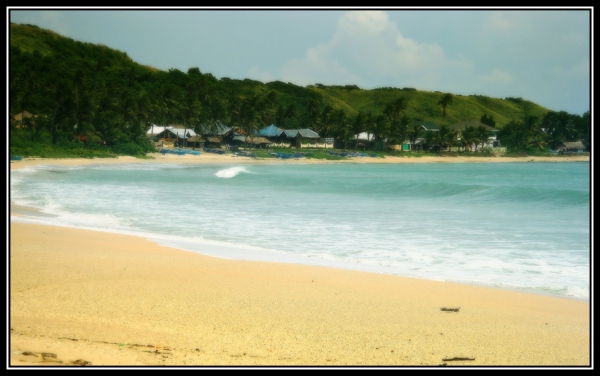 Blue Lagoon located in Maira-Ira Point, Pagudpud
Blue Lagoon located in Maira-Ira Point, Pagudpud
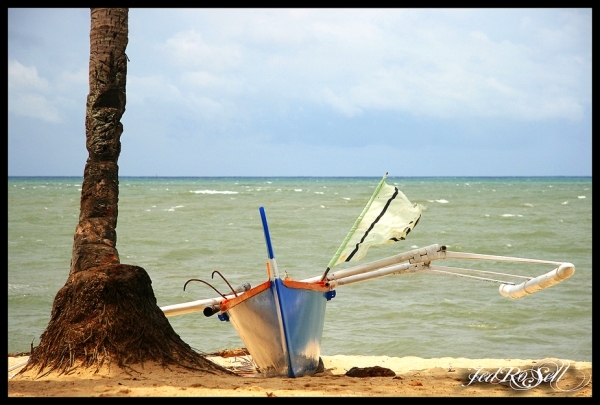 Saud Beach during the rainy season
Saud Beach during the rainy season
 Windmills from the neighbouring town of Bangui can be seen from Saud Beach
Windmills from the neighbouring town of Bangui can be seen from Saud Beach
Unfortunately, we do not have enough money to stay for another night and since the drive was very exhausting, dividing the trip into to would be a slack to the driver. From Pagudpud, we now go to the neighbouring town of Bangui where the famous windmills stood. To our dismay, it started to drizzle again.
When we were passing by Bangui on the way to Pagudpud, my heart pounded when I had a glimpse of the Windmill. Now, my heart is beating faster as we approach, closer and closer, to the NorthWind Bangui Bay Project. Seeing them on photographs and in real life were different. So that’s what it looks like in real life. It’s big. It’s huge. I don’t know what to say. Located at the North West tip of Luzon, the windmills turn wind from the ocean to electicity providing 40% of power sources of Ilocos Norte. Hopefully, more budget for projects like this should be allotted by the government since our country is surrounded by vast oceans and open seas. A small cafe called Kangkang Windmill Cafe (kangkang came from a bird making a ‘kangkang’ sound) not far from the windmills serving sandwiches, coffee, and refreshments.
 70-meter high windmill of Northwind Bangui Bay Project stretches for 9 kilometers along the Bangui Coast
70-meter high windmill of Northwind Bangui Bay Project stretches for 9 kilometers along the Bangui Coast
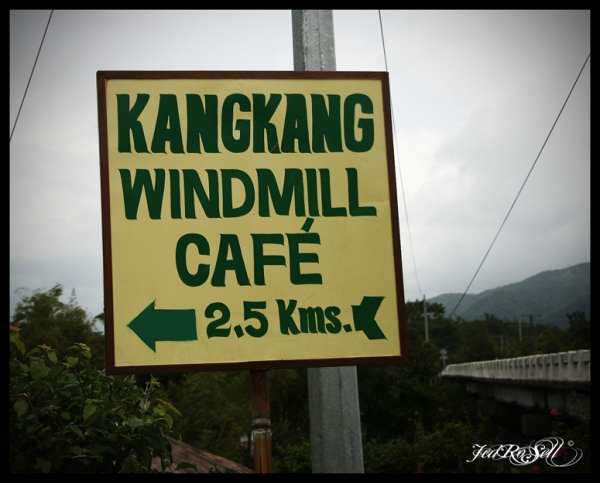 The cafe and the windmill is 2.5 km from the highway.
The cafe and the windmill is 2.5 km from the highway.
Further down the road towards the South is the coastal town of Burgos where beautiful rock formations are scattered along the beach. Since the town face the open sea, a century old lighthouse, known as Cape Bojeador stood on top of a hill. The light house guides ships for more than a hundred years and still operational today. Solar panels are installed to provide power for the large bulb on the tower. The facade, flooring, and construction of the light house looks similar to Capones Light house. Access to the light house is sometimes prohibited due to weather conditions.

Rocks along the coastal town of Burgos, Ilocos Norte
 Cape Bojeador Lighthouse in Burgos
Cape Bojeador Lighthouse in Burgos
 Bird’s eye view of the town from the spiral staircase of the old light house
Bird’s eye view of the town from the spiral staircase of the old light house
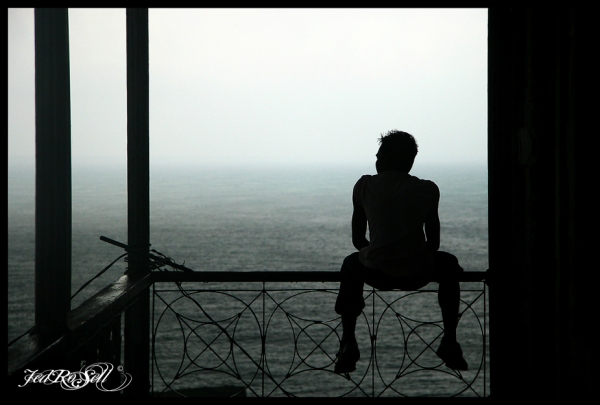 The vast South China Sea seems endless as one views on the veranda of the light house.
The vast South China Sea seems endless as one views on the veranda of the light house.
The Spanish influence is very evident in the the four corners of Philippines, and on the North Western corner churches are proof of their style in architecture. Famous among the churches of Ilocos Norte is the Saint Augustine Church, popularly known as the Paoay Church, a structure where its walls are witnesses both to the warfare strategies of the Katipunero’s during the Spanish Era and the guerillas during the Japanese Occupation. During the times of revolution, the belltower serves as a watchtower for Katipunero’s and guerillas alike. On the contrary, amidst the bloodshed during the colonial days, having influences like these added color to the country’s rich history and culture.
 Saint Augustine Church of Paoay
Saint Augustine Church of Paoay
Unfortunately, this is the end of the line for our Ilocos Norte trip. To be honest, I did a lot of mistakes in planning this trip due to the urge of being in several places (La Union, and Ilocos Sur) in one trip. There are several sights to see in Ilocos Norte that we missed like the sand dunes, Juan Luna Shrine, Museum of the Marcoses’, Ruins in Bacarra, the church in Badoc, etc. I was focused and determined we can go to all destinations in both provinces in Ilocos in a short period and tight budget.The next time I got the chance, my sights will be set on a single goal so I can learn more about a certain place, and get to know more about its culture. There’s simply a lot of things to do and sights to see in the province, and definitely I will be back for more.
Even though a heavy rains were on our way, some places missed, so little time to allot, and a tight budget to spend, we were still thankful, and happy that we’ve been in Ilocos Norte. We may not have been to all the places we have to be, but we are awed with the wonders of this province on top of Luzon.
==================================================================================
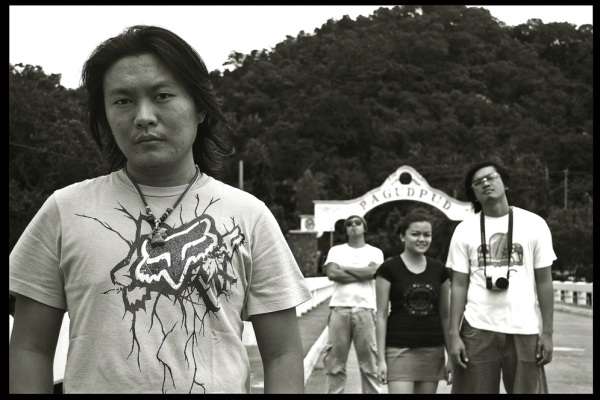 Amidst the storm warnings, these people were adventurous and eager to see how’s life up north (except for Paula who’s been here for the second time but). From left to right: Joey, Jed, Paula, Maru.
Amidst the storm warnings, these people were adventurous and eager to see how’s life up north (except for Paula who’s been here for the second time but). From left to right: Joey, Jed, Paula, Maru.
*this happened during 2008 so prices and places might have changed.
*more pictures in
Rate this:
Share this:
Like this:
-
July 9, 2012 at 4:31 am | #1Ilocos Norte: Cape Bojeador Lighthouse of Burgos « Biyaherong Barat
Leave a Reply Cancel reply
Popular Features
- Laiya in San Juan, Batangas
- Puting Buhangin Beach and Kuwebang Lampas in Pagbilao, Quezon
- The Pacific Recreation Kamp in Real, Quezon
- Baler, Aurora: A Joyful Joyride With Genesis' Joy Bus
- Liliw, Laguna: Arabela Restaurant & An On-Foot Side Trip To The "Tsinelas Capital"
- Best Boracay Island Vacation 2012
- Calamba, Laguna: 6th Philippine Wakeboard Nationals in REPUBL1C Wakepark
- Sanafe Lodge & Restaurant: Your "Home" In Banaue, Ifugao
- Crystal Beach Resort in San Narciso, Zambales
- Calinawan Cave, Daranak Falls & Other Tanay Destinations
FOLLOW Biyaherong Barat on Twitter
Biyahe Lokal offers CHEAP TRAVEL PACKAGES to beautiful beach destinations FROM AS LOW AS P1,900 PER PERSON
CLICK PHOTO TO GO TO BIYAHE LOKAL FACEBOOK PAGE. Destinations are Calaguas Island in Camarines Norte, Cagbalete Island in Quezon, The PaRK in Real, Quezon, San Antonio Coves in Zambales, Crystal Beach in San Narciso, Zambales and Laiya in San Juan, Batangas. Package includes land and sea transfers, meals, entrance fees, terminal fees, environmental fees, tents, camping equipments, etc. For inquiries, rates, and bookings, call or text YANI () or MARU (), or e-mail
Categories
- About Biyaherong Barat (2)
- Architecture (9)
- Barat Adventures (58)
- Biyahe Essentials (12)
- Biyahe Lokal Cheap Travel Packages (7)
- Biyaheng Aklan (6)
- Biyaheng Aurora Province (13)
- Biyaheng Bataan (1)
- Biyaheng Batangas (1)
- Biyaheng Camarines Norte (2)
- Biyaheng Camarines Sur (1)
- Biyaheng Catanduanes (3)
- Biyaheng Cavite (1)
- Biyaheng Cebu (2)
- Biyaheng Ifugao (4)
- Biyaheng Ilocos Norte (2)
- Biyaheng La Union (7)
- Biyaheng Laguna (4)
- Biyaheng Makati City (9)
- Biyaheng Manila (15)
- Biyaheng Pampanga (1)
- Biyaheng Pangasinan (1)
- Biyaheng Pasay (1)
- Biyaheng Pasig City (3)
- Biyaheng Quezon Province (9)
- Biyaheng Rizal Province (6)
- Biyaheng Zambales (10)
- Food (1)
- Grab Good Grubs (3)
- Letter From A Fellow Traveler (1)
- Modes Of Transportation (3)
- People (19)
- Places (28)
- Snippets & Shortcuts (70)
- Sports (1)
- Still Life (4)
- Who Is Biyaherong Barat (1)
Look Into Biyaherong Barat
Administrator, Author, & Photographer
More photos in Flickr
|
Tags
Biyahero Hits
- 61,011 hits


